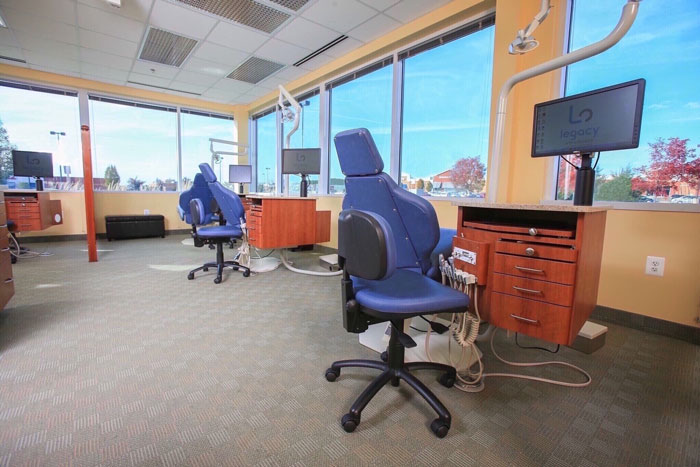The Ultimate Guide To Legacy Orthodontics
The Ultimate Guide To Legacy Orthodontics
Blog Article
Some Known Incorrect Statements About Legacy Orthodontics
Table of ContentsIndicators on Legacy Orthodontics You Need To KnowAn Unbiased View of Legacy OrthodonticsAn Unbiased View of Legacy OrthodonticsThe smart Trick of Legacy Orthodontics That Nobody is Talking AboutThe Facts About Legacy Orthodontics Revealed
In addition, we use flexible treatment routines, adaptable settlement choices and an enjoyable, satisfying experience.An orthodontist is a dental practitioner trained to detect, protect against, and treat teeth and jaw abnormalities. They remedy existing conditions and are educated to determine troubles that may develop in the future. Orthodontists function with people of every ages, from kids to adults. Individuals frequently link a best smile with good health.
Malocclusion, or misaligned teeth, can cause dental concerns, consisting of tooth decay, gum tissue disease, and hard or painful chewing. Yet not everyone is born with straight teeth. If you have a poor bite or huge spaces between your teeth, you might desire to seek advice from a dental expert specializing in orthodontic care.
Legacy Orthodontics for Beginners
( Photo Credit: DigitalVision/Getty Images) Orthodontists utilize dealt with and detachable oral gadgets, like braces, retainers, and bands, to alter the setting of teeth in your mouth. Orthodontic treatment is for dental problems, consisting of: Crooked teethBite problems, like an overbite or an underbiteCrowded teeth or teeth that are as well much apartJaw misalignmentThe objective of orthodontic therapy is to boost your bite.
A healthy and balanced bite guarantees you can consume, chew, and speak effectively. While you could think about orthodontists as generally for kids or teenagers who need braces, they can remedy oral troubles at any kind of age. Orthodontists participate in college, dental institution, and orthodontic institution. After college graduation, they invest 2 or 3 years in an orthodontic residency program.
All orthodontists are dental practitioners, but not all dentists are orthodontists. Orthodontic residency programs use intensive, focused instruction for oral professionals. They concentrate on 2 locations: Exactly how to appropriately and safely relocate teeth Exactly how to correctly direct advancement in the teeth, jaw, and faceOnce an orthodontist has completed training, they have the option to come to be board licensed.
The Basic Principles Of Legacy Orthodontics
Malocclusion leads to tooth congestion, an irregular jaw, or uneven bite patterns. Malocclusion is normally treated with: Your orthodontist affixes metal, ceramic, or plastic square bonds to your teeth.
Some people require a headgear to assist move teeth right into line with stress from outside the mouth. A retainer is a custom-made tool that maintains your teeth in place.
They're usually made use of on children. They can create extra room in the mouth without having to pull teeth. If you have a significant underbite or overbite, you could need orthognathic surgical treatment (additionally called orthodontic surgery) to lengthen or shorten your jaw. Orthodontists utilize cables, medical screws, or plates to sustain your jaw bone.
You might require to see an orthodontist if you have: Crowding or not enough space for all of your teethOverbite, when your top teeth come over your base teethUnderbite, when your base teeth are too much forwardSpacing or concerns with gapsCrossbite, which is when your top teeth fit behind your base teeth when your mouth is closedOpen bite or a vertical space between your front bottom and upper teethMisplaced midline, when the facility of your base and top teeth do not align Dealing with an oral malocclusion can: Make attacking, eating, and talking easierImprove the balance of our face and your general appearanceEase discomfort from temporomandibular joint conditionsSeparate your teeth and make them less complicated to clean, aiding protect against tooth degeneration or dental caries It's often a dental professional who first notifications misaligned teeth during a regular exam.
The Best Guide To Legacy Orthodontics

During your first orthodontic examination, you'll likely have: A dental examPhotos taken of your face and smileDental X-raysPanoramic (360 level) X-rays of your face and headImpressions to develop mold and mildews of your teethThese tests will assist your orthodontist recognize how to continue with your therapy. leesburg braces. An orthodontist is a dental professional that's had training to treat your teeth and jaw
An orthodontist is focused on your bite, so something like a chipped tooth would certainly be handled by a dental expert. Orthodontists are concentrated on your bite, or the way your teeth fit with each other, and the straightness of your teeth.
Ever wondered exactly how celebs always appear to have flawlessly aligned teeth? The answer often exists in the competent hands of an orthodontist. However what exactly does an orthodontist do? Orthodontists are oral experts who focus on remedying irregularities in the teeth and jaws. Their experience goes past just producing an attractive smile; it extends to improving your general dental wellness and feature.
What Does Legacy Orthodontics Do?

While braces are the most frequently identified orthodontic therapy, orthodontists have a diverse toolkit at their disposal. The specific method selected depends upon the extent of the case, the individual's age, and specific choices. These tried-and-true braces utilize a system of brackets bonded to the teeth and linked by cables.
Clear aligners, like Invisalign, are a popular alternative for patients looking for an extra discreet therapy choice. These removable trays are tailor-made to gradually move the teeth's setting. Headgear might be made use of along with braces or aligners to apply additional targeted pressures, specifically for useful reference fixing jaw discrepancies. In cases of narrow jaws, palatal expanders can be made use of to develop room for correct tooth positioning.
Report this page